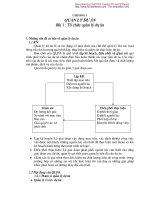Chương 1: Quản lý dự án pot
Bạn đang xem bản rút gọn của tài liệu. Xem và tải ngay bản đầy đủ của tài liệu tại đây (327.88 KB, 14 trang )
McGraw-Hill/Irwin © 2008 The McGraw-Hill Companies, All Rights Reserved
Modern Project
Management
Chapter 1
1-2
1-3
What Is a Project?
Project Defined
A complex, nonroutine, one-time effort limited by time,
budget, resources, and performance specifications
designed to meet customer needs.
Major Characteristics of a Project
Has an established objective.
Has a defined life span with a beginning and an end.
Typically requires across-the-organizational
participation.
Involves doing something never been done before.
Has specific time, cost, and performance
requirements.
1-4
Programs versus Projects
Program Defined
A series of coordinated, related, multiple projects that
continue over an extended time and are intended to
achieve a goal.
A higher-level group of projects targeted at a common
goal.
Example:
o
Project: completion of a required course in project
management.
o
Program: completion of all courses required for a
business major.
1-5
Comparison of Routine Work with Projects
TABLE 1.1
Routine, Repetitive Work
Taking class notes
Daily entering sales receipts into
the accounting ledger
Responding to a supply-chain
request
Practicing scales on the piano
Routine manufacture of an Apple
iPod
Attaching tags on a manufactured
product
Projects
Writing a term paper
Setting up a sales kiosk for a
professional accounting meeting
Developing a supply-chain
information system
Writing a new piano piece
Designing an iPod that is
approximately 2 X 4 inches,
interfaces with PC, and stores
10,000 songs
Wire-tag projects for GE and
Wal-Mart
1-6
Project Life Cycle
FIGURE 1.2
1-7
The Challenge of Project Management
The Project Manager
Manages temporary, non-repetitive activities and
frequently acts independently of the formal organization.
o
Marshals resources for the project
o
Provides direction, coordination, and integration to the
project team
o
Manages a diverse set of project stakeholders
o
Dependent upon others for technical answers
o
Is responsible for performance and success of the
project
Must induce the right people at the right time to address
the right issues and make the right decisions.
1-8
The Importance of Project Management
Factors Leading to the Increased
Use of Project Management:
Compression of the product life
cycle
Global competition
Knowledge explosion
Corporate downsizing
Increased customer focus
Small projects that represent
big problems
1-9
Growth in PMP Certification
1-10
Integrated Project Management Systems
Problems Resulting from the Use of Piecemeal Project
Management Systems:
Do not tie together the overall strategies of the firm.
Fail to prioritize selection of projects by their
importance of their contribution to the firm.
Are not integrated throughout the project life cycle.
Do not match project planning and controls with
organizational culture to make appropriate
adjustments in support of project endeavors.
1-11
Integrated
Managemen
t of Projects
FIGURE 1.3
1-12
The
Technical
and
Sociocultura
l
Dimensions
of the
Project
Manageme
nt Process
FIGURE 1.4
1-13
An Overview of Project Management 4e.
1-14
Key Terms
Program
ISO 9000
Project
Project life cycle
Project management professional (PMP)
Sociotechnical perspective









